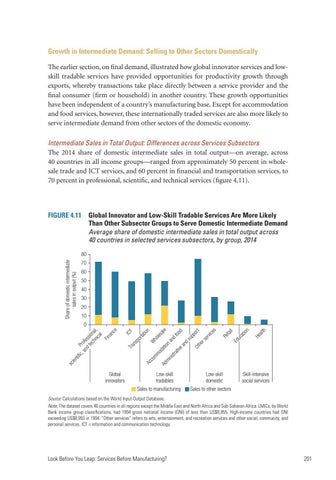Growth in Intermediate Demand: Selling to Other Sectors Domestically The earlier section, on final demand, illustrated how global innovator services and lowskill tradable services have provided opportunities for productivity growth through exports, whereby transactions take place directly between a service provider and the final consumer (firm or household) in another country. These growth opportunities have been independent of a country’s manufacturing base. Except for accommodation and food services, however, these internationally traded services are also more likely to serve intermediate demand from other sectors of the domestic economy. Intermediate Sales in Total Output: Differences across Services Subsectors The 2014 share of domestic intermediate sales in total output—on average, across 40 countries in all income groups—ranged from approximately 50 percent in wholesale trade and ICT services, and 60 percent in financial and transportation services, to 70 percent in professional, scientific, and technical services (figure 4.11).
FIGURE 4.11 Global Innovator and Low-Skill Tradable Services Are More Likely Than Other Subsector Groups to Serve Domestic Intermediate Demand Average share of domestic intermediate sales in total output across 40 countries in selected services subsectors, by group, 2014 Share of domestic intermediate sales in output (%)
80 70 60 50 40 30 20 10
Ac
h alt
co m
He
tai l Ed uc ati on
Re
mo les da ale Ad tio mi na nis n df tra oo tiv d ea nd su pp or Ot t he rs erv ice s
n
ho
tio rta
W
an
sp o
ICT
Global innovators
Tr
sc ien tifi c, Pro an fe d t ss ec ion hn al, ica l Fin an ce
0
Low-skill tradables Sales to manufacturing
Low-skill domestic
Skill-intensive social services
Sales to other sectors
Source: Calculations based on the World Input-Output Database. Note: The dataset covers 40 countries in all regions except the Middle East and North Africa and Sub-Saharan Africa. LMICs, by World Bank income group classifications, had 1994 gross national income (GNI) of less than US$8,955. High-income countries had GNI exceeding US$8,955 in 1994. “Other services” refers to arts, entertainment, and recreation services and other social, community, and personal services. ICT = information and communication technology.
Look Before You Leap: Services Before Manufacturing?
201

